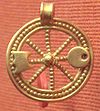|
Lenus
Lenus (Ancient Greek: Ληνός[4]) was a Celtic god of healing,[1] good fortune, and protection in battle,[2] worshipped mainly in eastern Gaul, where he was almost always identified with the Roman god Mars. NameThe Gaulish theonym Lenos has been derived from a stem lēno-, which could mean 'wood, bocage' (cf. Welsh llwyn 'bush, grave, shrub').[5] His name most often appears in inscriptions as "Lenus Mars", rather than "Mars Lenus" as would be expected from other most syncretized names. His name also occasionally appears as "Mars Laenus".[6] While the bulk of religious inscriptions to Lenus Mars are in Latin, there is one Latin-Greek bilingual inscription that identifies the god as "Lēnos ... Arēs" in the Greek version.[4] CultLenus was an important god of the Treveri, who had large sanctuaries at medicinal springs at Trier and the Martberg by Pommern in what is now Germany. Two dedications to him are also known from southwestern Britain (Chedworth and Caerwent). Edith Wightman characterizes him as “one of the best examples of a Teutates, or god of the people, equated with Mars—protector of the tribe in battle, but also [...] bestower of health and general good fortune” (p. 211).[2] His sanctuary "Am Irminenwingert" at Trier had a large temple, baths, smaller shrines and a theatre; that on the Martberg also included a large variety of buildings, probably including rooms for health-seeking pilgrims to stay. Notwithstanding his associations with healing, Lenus Mars is depicted classically as a warrior with Corinthian helmet in a bronze statuette from the Martberg.[2] At Trier, Lenus Mars's divine partners were the Celtic goddess Ancamna and the Roman Victoria,[7] as well as the Xulsigiae, who are perhaps water nymphs.[2] An inscription from Kaul in Luxembourg appears to invoke Lenus Mars "Veraudunus" along with the Celtic goddess Inciona.[8] Lenus was not the only Celtic god identified with Mars by the Treveri; others, such as Iovantucarus (apparently a protector of youth), Intarabus, Camulos, and Loucetios were identified with Mars and perhaps, by extension, with Lenus. "Lenus Mars" is accompanied by the epithets "Arterancus"[9] and "Exsobinus"[10] on one inscription each. The epithet "Exsobinus" has been interpreted to mean 'fearless', a name shared with the Batavian goddess Exomna.[11] In Britain, Lenus was identified with three other gods, namely the Roman Mars, and the British gods Ocelus and Vellaunus,[1] as can be evidenced from the following inscription found at the base of a statue in Caerwent:[1][12][3]
GalleryImages of Lenus and Shrines References
Bibliography
Wikimedia Commons has media related to Lenus Mars. External links |
||||||||||||||||||||



